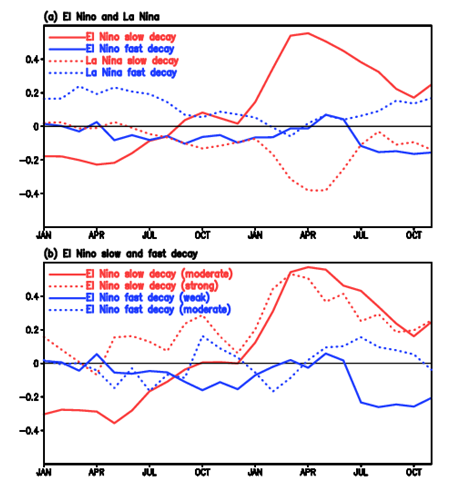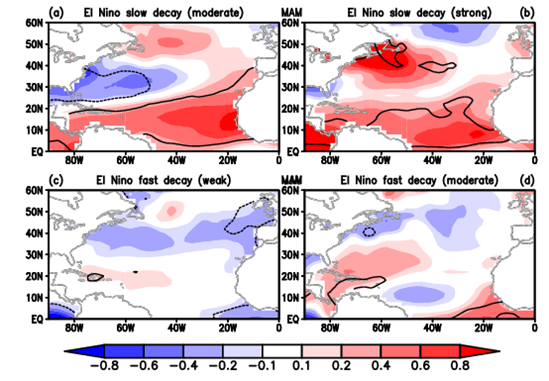Editor: 邵丹蕾 Author: Renguang WU Time: 2020-04-10 Number of visits :180
The North Atlantic sea surface temperature (SST) anomalies can affect the climate variability in the surrounding regions. The tropical Pacific SST anomalies associated with El Niño and La Niña events is an important factor of the North Atlantic SST variations is. In this study, Wu et al. (2020) investigated the dependence of the northern tropical Atlantic (NTA) SST response to El Niño and La Niña events on the decay time and amplitude of tropical Pacific SST anomalies.
The SST warming in the NTA region is earlier, larger, and more persistent in the slow than early decaying El Niño events (Fig. 1a).The SST cooling in the NTA region is larger in the slow than fast decaying La Niña events (Fig. 1a). Latent heat flux is a dominant term in the NTA SST change in preceding winter-early spring in both El Niño and La Niña events and in the difference of the NTA SST anomaly between slow and fast decaying El Niño and La Niña events. The zonal and meridional advections have an opposite effect on the NTA SST warming in slow decaying El Niño events.
The SST warming in the NTA region is comparable in slow decaying moderate and strong El Niño events (Fig. 1b). Nevertheless, the distribution of the SST anomalies in the mid-latitude North Atlantic Ocean shows a notable difference between the two types of late decaying El Niño events (Figs. 2a-b). While the SST anomalies in MAM display a tripole pattern in moderate events (Fig. 2a), they tend to show a quadruple pattern in strong events with large positive SST anomalies in the western mid-latitudes (Fig. 2b). This difference is attributed to latent heat flux anomalies that display a tripole and quadruple pattern, respectively, in moderate and strong events in winter-early spring. The different distribution of latent heat flux anomalies is associated with the wind difference.
The distribution of SST anomalies in the North Atlantic Ocean also displays notable differences between the fast decaying weak and moderate El Niño events (Figs. 2c-d). In moderate events, the SST anomalies are characterized by a tripole pattern with negative anomalies in the tropics and mid-latitudes and positive anomalies in the subtropics (Fig. 2d). Such SST anomaly distribution is related to a similar tripole pattern of latent heat flux anomalies. In turn, the distribution of latent heat flux anomalies is largely determined by wind anomalies.
Wu, R.*, M.-Y. Lin, H.-M. Sun, 2020: Impacts of different types of El Niño and La Niña on northern tropical Atlantic sea surface temperature. Climate Dynamics, 54(9), 4147-4167. https://doi.org/10.1007/s00382-020-05220-7

Figure 1 Temporal evolution of composite NTA SST anomalies (˚C) in (a) slow (red-solid line) and fast (blue-solid line) decaying El Niño events and slow (red-dot line) and fast (blue-dot line) decaying La Niña events and (b) slow decaying moderate (red-solid line) and strong (red-dot line) El Niño events and in fast decaying weak (blue-dot line) and moderate (blue-dot line) El Niño events.

Figure 2 Composite March-May (MAM) SST anomalies (˚C) in slow decaying moderate (a) and strong (b) El Niño events and in fast decaying weak (c) and moderate (d) El Niño events. Contours denote that the composite anomalies are significant at the 95% confidence level according to the one-tailed Student’s t test.
